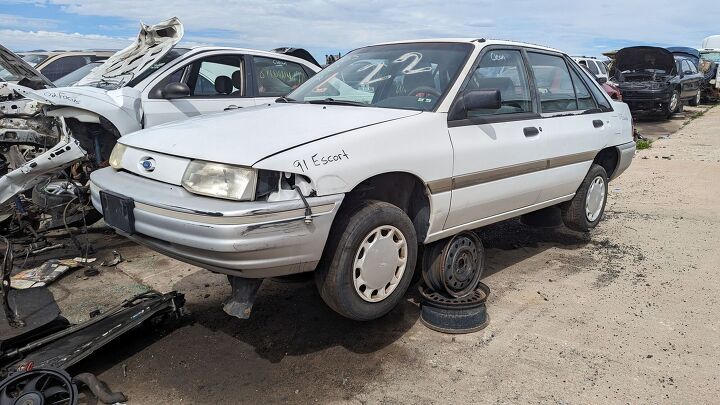Junkyard Find: 1991 Ford Escort LX 4-Door Hatchback

The Ford Escort began life in 1955, in Britain (just a year after World War II-era food rationing finally ended), as a cheapified version of the Ford Squire wagon. After the pinnacle of rear-wheel-drive Escort action on that side of the Atlantic, a front-wheel-drive version appeared over there; a not-so-closely-related North American cousin showed up as a 1981 model.
Fast-forward a decade and Dearborn had just the ticket for the second-generation of Escort: a sibling to the Mazda 323/ Protegé, which debuted as a 1991 model. Here's one of those first-year Mazdafied Escorts, found in a Denver-area car graveyard.
The early 1990s were interesting times for Ford designs, with the demise of the boxy LTD Crown Victoria and the introduction of the new Taurus and Crown Victoria with this distinctive grille treatment.
Though the second-generation North American Escort was a Mazda Protegé under the skin, Ford held onto the good old UK-developed CVH straight-four engine, a crypto-OHC design that displaced 1.9 liters in this application.
The Escort GT for 1991 got a Mazda DOHC 1.8-liter engine, from the same family that powered the Mazda Miata and Mercury Capri. If you got the regular Escort that year, though, you got the cam-in-head CVH with 88 horsepower and 108 pound-feet. That's what's in this car.
A five-speed manual transmission was base equipment, even in the cheapskate Escort Pony, but the original purchaser of this automobile sprang for an extra $732 ($1,662 in 2023 dollars) for this four-speed overdrive automatic.
The LX was the top trim level for the 1991 Escort sedan, and the MSRP on this one was $9,095 (around $20,656 after inflation).
It looks like a sedan, but that "trunk" is really a hatch.
Did you get air conditioning as standard equipment in the 1991 Escort? No, you did not! The refrigerated air in this car added $744 to the out-the-door price, or about $1,690 in today's money.
Cars of a few decades ago seem cheap by today's standards, but note that the automatic transmission and A/C—which come at no extra cost in nearly all the most miserable 2023 econoboxes—added the 2023 equivalent of $3,352 to the bottom-line cost of this car.
You did get an AM/FM radio at no extra cost in the '91 Escort LX, but adding the ability to play cassettes cost another $155 ($352 now). Hey, if you wanted to listen to your new Jane's Addiction tape in 1991, you had to pay.
This one just squeaked past the 175,000-mile mark during its life.
Remember these hateful automatic seat belts? In the early 1990s, US-market new cars without airbags had to have automatic belts.
Mr. Import is now Mr. Escort (though he's still driving a Mazda).
Wishing for style and performance in a small car? Start experience.
[Images: The author]
Become a TTAC insider. Get the latest news, features, TTAC takes, and everything else that gets to the truth about cars first by subscribing to our newsletter.

Murilee Martin is the pen name of Phil Greden, a writer who has lived in Minnesota, California, Georgia and (now) Colorado. He has toiled at copywriting, technical writing, junkmail writing, fiction writing and now automotive writing. He has owned many terrible vehicles and some good ones. He spends a great deal of time in self-service junkyards. These days, he writes for publications including Autoweek, Autoblog, Hagerty, The Truth About Cars and Capital One.
More by Murilee Martin
Latest Car Reviews
Read moreLatest Product Reviews
Read moreRecent Comments
- Varezhka The biggest underlying issue of Mitsubishi Motors was that for most of its history the commercial vehicles division was where all the profit was being made, subsidizing the passenger vehicle division losses. Just like Isuzu.And because it was a runt of a giant conglomerate who mainly operated B2G and B2B, it never got the attention it needed to really succeed. So when Daimler came in early 2000s and took away the money making Mitsubishi-Fuso commercial division, it was screwed.Right now it's living off of its legacy user base in SE Asia, while its new parent Nissan is sucking away at its remaining engineering expertise in EV and kei cars. I'd love to see the upcoming US market Delica, so crossing fingers they will last that long.
- ToolGuy A deep-dive of the TTAC Podcast Archives gleans some valuable insight here.
- Tassos I heard the same clueless, bigoted BULLSHEET about the Chinese brands, 40 years ago about the Japanese Brands, and more recently about the Koreans.If the Japanese and the Koreans have succeeded in the US market, at the expense of losers such as Fiat, Alfa, Peugeot, and the Domestics,there is ZERO DOUBT in my mind, that if the Chinese want to succeed here, THEY WILL. No matter what one or two bigots do about it.PS try to distinguish between the hard working CHINESE PEOPLE and their GOVERNMENT once in your miserable lives.
- 28-Cars-Later I guess Santa showed up with bales of cash for Mitsu this past Christmas.
- Lou_BC I was looking at an extended warranty for my truck. The F&I guy was trying to sell me on the idea by telling me how his wife's Cadillac had 2 infotainment failures costing $4,600 dollars each and how it was very common in all of their products. These idiots can't build a reliable vehicle and they want me to trust them with the vehicle "taking over" for me.













































Comments
Join the conversation
I still drive my '91 Escort. Never fails to start. 5-speed, a/c (still runs on freon), cassette deck. Fun to drive.
I think we were lucky to get the Mazda as an Escort here in North America. The real Ford Mk 2 FWD Escort made in Europe was no winner. Knew several people who had these disguised Mazdas and they weren't bad at all. The CVH engine was a nasty throbber, but the 1.8 DOHC Mazda in the GT was a very nice little spinner indeed.